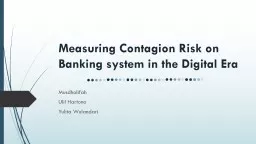

Musdholifah Ulil Hartono Yulita Wulandari Introduction A bank has various risks inherent in it Financial institutions have an exposure effect towards each other that can be seen from the practice of interbank market ID: 911556
Download Presentation The PPT/PDF document "Measuring Contagion Risk on Banking syst..." is the property of its rightful owner. Permission is granted to download and print the materials on this web site for personal, non-commercial use only, and to display it on your personal computer provided you do not modify the materials and that you retain all copyright notices contained in the materials. By downloading content from our website, you accept the terms of this agreement.
Slide1
Measuring Contagion Risk on Banking system in the Digital Era
MusdholifahUlil HartonoYulita Wulandari
Slide2Introduction
A
bank
has various risks inherent in it.
Financial institutions have an exposure effect towards each other that can be seen from the practice of interbank market (Kapoor, 2010; 19-20).
Globalization leads to the connections between financial institutions and money markets, domestically and
internationallycollapse of a financial institution in one country, which might spread to other institutions or countries (Shah, 1997
), we called it contagion or systemic risk.
Slide3Literature Review
Rescue costs for banks that experience stressed conditions in preventing the systemic collapse are quite
large (Shah, 1997)
Memmel
& Sachs,
(2013)
Interbank
market is the most important risk distribution channel for banks and other financial
institutions.
Schoenmaker
(1996
)
Distribution
channel can also occur in the context of liquidity and refinancing
Philippas
, et al. (2015)
A
dapted
the
Barabási
–Albert model (BA model
).
The shocks in small banks caused huge losses in a whole so that there was a need for a crisis restraint policy. T
Gai
, et al.
(
2011)
Concentration
and complexity are the main causes of the fragility of the financial institutions until they are able to be the channel which spread shocks in the economic
cycle.
Aharony
&
Swary
(1983)
The
spread of contagion effects through information and credit channels. The spread of contagion effects through information channels is divided into
pure and noisy contagion.
De
Bandt
&
Hartmann
(2000)
The spread of contagion risk can
occur
through foreign exchange transactions in the market and the fair value of financial assets
Slide4HypothesisH1: There is a causal relationship between interbank banking pressures
H2: There is an effect of shocks on bank i towards bank j
This study aimed at determining the contagion risk in several banks in Indonesia.
T
he
samples used in this study were banks that provided financial reports from 2007-2016.
Based
on that characteristic, there were 18 banks taken as the research samples.
The
data used in this study were audited financial statements and were available on each bank’s website or on the website of Indonesian Stock Exchange.
Method
Slide5Three variables were used to measure the
financial contagion risk indicator
(
Christiawan
&
Arfianto
, 2013):
1
2
3
The method used
was
Vector
Autoregression
(VAR
)
Slide6Result & Analysis
Bank CIMB Niaga
BTN, BCA, BRI,
BNI,Commonwealth Bank Indonesia, Bank
Permata, Bank Mega, KEB Hana Bank, J-Trust Indonesia Bank
Bank BCA Bank
Mayapada International, Maybank Indonesia, Bank Mega, Bank
Resona Perdania
BRI
BNI, Bank Ekspor
Indonesia, Mayapada Bank,
Bank Nusantara Parahyangan
Bank Mandiri
BRI, BNI, Commonwealth
IndonesiaBank Commowealth
Indonesia BNI, Bank
Mega
BTN
BCA
BNI Bank
Danamon Indonesia
J-Trust Bank
BNI.
Mayapada International Bank
BNI
Bank Permata
Bank
Mayapada International & BNI.
Bank Woori Saudara Indonesia
BNI
Bank Ekspor Indonesia
Maybank Indonesia &
Bank
Resona
Perdania
One-way Causalities
To answer the first hypothesis, the granger Causality test was
conducted
using α of 5
%, the results:
two-way relationship or causality between BCA and Bank
Mandiri
.
Two-way Causality
Slide7Vector Auto Regression Analysis
Large banks with large asset values could reduce the risk of the shock impacts that occurred in other banks. In some cases, the shock of other banks gave benefits to the aforementioned banks, example: BNIThe Bank shocks could also be caused by the condition of the bank in the
past.
In several banks with not-too-large assets, the effects of shocks did not cause significant shock to other banks.The interbank
shocks, even though they were statistically positive, they were not too significant because the shock did not directly cause default conditions to other
banks and did not cause a systemic crisis in banks in Indonesia.Supported by
Zakaria (2015) and
Christiawan and Arfianto (2013)
Slide8Conclusion & Recommendation
Aims of this study: analyzing the pressures and the impacts of the shock effect from one bank to other banks.The spread of the contagion risk in this study was measured from the interbank market risk channels by taking the bank vulnerabilities in interbank account interactions, the risks of the securities market and foreign exchange market.The test results show that there is one-way and two-way causalities, for two-way relationship or causality it found that there is causality between BCA and Bank Mandiri
.
There
is an impact of the shock from banks j towards bank i
, of which the statistics are not always positive. This shows that there is pressure among the banks in Indonesia.the shock value tends to be
small so that it does not lead to direct systemic crisis.The limitation in this study is it
does not take the distribution channel in terms of liquidity, therefore, the future studies are expected to take the contagion risk assessment in terms of liquidity into account.
1
2
Slide9Thank you